|
Recent Entries to this Blog
My new life is shapping up nicely
Posted: 23 Dec 2006 Posted: 29 Oct 2006 Posted: 09 Oct 2006 Posted: 27 Sep 2006 Posted: 25 Sep 2006 All Entries |
Pinkiered's BlogRoses, Roses and more Roses PLEASE!
Prince Poins
Category: Royal Poinciana | Posted: Wed Jun 14, 2006 8:07 pm Here he is this morning. So big! 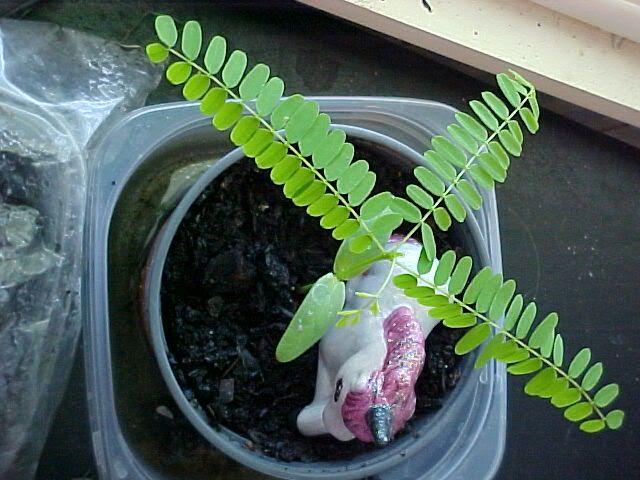
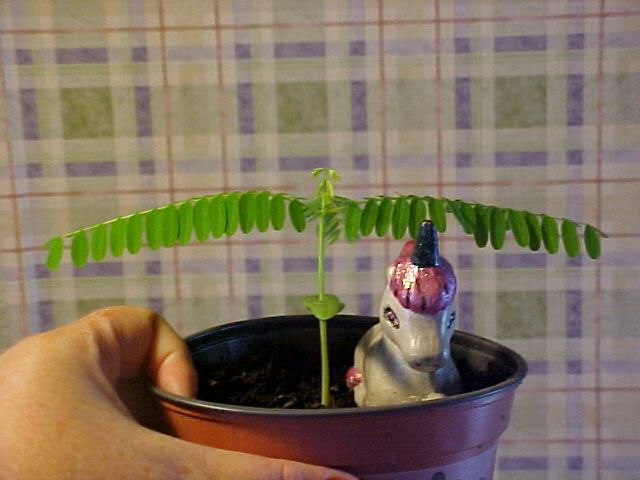
This blog entry has been viewed 518 times
This awful drought
Category: The Garden | Posted: Wed Jun 14, 2006 7:45 pm When I first moved in here, I had high hopes. As the weather warmed up, I had stuff planted and planned. But we have had what the locals are calling one of the worse droughts so early in the season. Figures..... My gardening project right now is trying to keep everything alive. Ive lost four pots of seedlings in the last 3 days and have tow left that are struggling, because of this heat and drought. They were growing good and I was watering them every morning and evening but its so dry out, I dont know how much of the water is actually getting to the roots. So I lost them and one of my morning glorys. I think my rain tree is next. All the leaves have died and I dont see any new buds on it. Ive lost a few of my elephant ears and my fern tree looks terrible. My banana trees are showing the worse of it I think. Ive lost most of my petunias and red saliva. And the last of my tomato plants has perished.Out of 49 I have lost them all. :( And both my mints are on their last legs. My rose blooms are scattered and are blooming small, if they are blooming at all.I have few that arent even forming buds or new growth. Even my white Yucca is looking kind of stunted. The only things that are doing well, are my Mexican heather, aspurgus(SP) fern, the large Bird Of Paradise and foutain grass. Figures. I am watering them everyday. But Im not sure how much is actually making itself to the roots. I gave them all a good soak earlier in the week. I think Ill have to do it again. Its hard to fight Mother Nature. This blog entry has been viewed 527 times
Let me be nasty for a min!!!
Category: Pinkies LIfe | Posted: Sun Jun 11, 2006 11:35 pm Some ppl just shouldnt add their genes to the gene pool!!! At the end of our lane is a very large field. Running through that field is the pipes that carry our water. Now, these pipes arent covered and you can see them PLUS theres a very clear ,very large sign that reads as follows, " Warning, water pipes" .....hmmmmmmmm wonder if that means something?? Guess NOT! Our landlord hired some dumb nut to use a tractor to cut the feild. This fool just ran over the pipes....THE ONES THAT CARRY WATER TO OUR HOUSES!!! So now, I have a washer full of soapy clothes. I had to turn it off when the dishwasher suddenly stopped running water. Then that fool has the nerve to look at three p***ed off women, me and both my neighbors, one holding a soapy child, and tell us, "Well, I didnt know it was there" ARE YOU KIDDING ME????? How could you possibly miss a HUGE sign that starts with the word......WARNING!!! That means BE CAREFUL!!!! THERES SOMETHING THERE THAT YOU SEE BE ON THE LOOK OUT FOR!!!! It doesnt mean, lets run all over everything and hope to god its ok when Im done!!!!! Some ppls kids!!!!! This blog entry has been viewed 479 times
Organic treatments and prevention for Roses
Category: Roses | Posted: Sun Jun 11, 2006 10:32 pm This is recipes for organic sprays and ways to treat your roses with. There is nothing here that I havent tried. If its here, it works. Ill add to this as I expermint. Feel free to ask questions or comments. As you learn, I learn. Before using ,please read. ~Spray in the early morning or the cool of evening as plants may "burn" or have a reaction to what you are using in excessive heat. ~perform a test on a small portion of the plant material first, wait 24 hours to observe any negative reaction and proceed if there is no damage. ~more is not necessarily better; if you are not getting good results don't increase the strength of these remedies without testing first. ~target just the area you need to treat. ~when working with sprays or dusts always protect your exposed skin and face. Some of these ingredients can be very irritating to your skin, eyes and mucous membranes, especially any hot pepper sprays. Diseases Powdery Mildew The Vinegar Rinse 2 tablespoons white or cider vinegar (5 percent) 1 gallon water Pour undiluted vinegar into the container of a Gilmour Metering Dial (dial-a-spray) hose-end sprayer. Set the dial to deliver 2 tablespoons per gallon and start spraying. Soak the entire plant, making sure to get the undersides of the leaves. Spray in the morning. Apply once a week as needed until the weather warms up. I use a dial a sprayer. Works like a charms but if you dont have one, mix 2 tablespoons per gallon of water and mix well. Add to hand held sprayer. For Black spot Fungus to fungus spray Mix ordinary fat-free milk with water in a 1:1 ratio and apply it using a spray bottle. Spray the solution directly onto the clean leaves of your roses. The milk-and-water solution coats the leaves and leads to the growth of an invisible--and harmless--fungus. That benign fungus will prevent the formation of damaging black spot fungus. Basic Baking powder spray mix 3 tablespoons of baking soda into 1 gallon of water and spray the roses. PEST PLEASE NOTE: Nothing below works on Leaf beetles.Im told there is no organic treatment for the leaf beetle. please see blog link below for more details on this beetle. http://www.gardenstew.com/blog/e283-63-leaf-beetle-on-roses.html For Japanese beetles Dishwashing detergent jar ~Put 1 tablespoon of liquid dishwashing detergent into a wide mouthed jar. Add 2 inches of water. Pick or knock the beetles into the jar and they will die in minutes. I am using this on my Passion vine to deter all the bugs and it works great. I would think that it works on roses too. Detergent,oil and alcohol spray ~Mix 1 teaspoon of liquid dishwashing detergent with 1 cup of vegetable oil and shake well; then add it to 1 quart of water. Add 1 cup of rubbing alcohol and shake vigorously. Pour this mixture into a spray bottle and use it at ten-day intervals on pests. Cayenne pepper spray The orignal recipe goes as follows: 2 tablespoons of cayenne powder to every 2 cups of water. Shake well and spray on roses coating top of leaves, bottom of leaves, stems, and flowers/buds. I use a dial a sprayer so I had to figure out how to do it as with a dial a spray it has to be liquid so I added 5 tablespoons of cayenne powder to one cup of water. Shook well and poured it into my sprayer. I then turned the dial on 2 oz to every gallon. It does work. I have not a bug on my roses...not even to rest except the Leaf beetle. If you have a recipe of organic treatment and/or prevention, feel free to leave me a comment with the recipe and Ill try it. If It works , Ill add it to my list. Ot if you have tried one of the above recipes and it works for something other besides with it is listed for, please leave me a comment so that I might test it. Thank you!! Last edited: Thu Jun 15, 2006 10:11 pm This blog entry has been viewed 17700 times
Living with depression.
Category: Pinkies LIfe | Posted: Sun Jun 11, 2006 4:10 am I suffer from depression and its been kicking me down these last few weeks. Its gotten pretty bad in last few days. All I want to do is sleep but I wont let myself. I have to stay on top of it until Robs health insurance kicks in. With this job it was suppose to be 3 months but this week is the second week in the last three that he hasnt worked. We cant afford him not to work. As it was we were living pay check to pay check. The whole point of the move out here was to get ahead but it seems since moving out here, we have gotten futher behind.He starts another new job this Monday. Its on another rig with a different company. He love the job he has now so he is going to tell his boss that when it picks up, he will come back. I know that hasnt helped my depression. As an artist, I have all these image in my head and new ones popping up all the time. I havent said it before but my depression is the main reason for my myspace contest. I have all these images but nothing seems to fit the way I feel. How do you paint depression? Or even with depression? Its hard, its an every day stuggle for me to get out of bed and function as a normal person. When ppl find out I suffer from depression, they make statements like, I never knew that or You dont seem like it.... or my fav, You seem normal. I have found out that depression is very normal. More ppl are being honest about their depression now adays. I guess its to help ppl. Which I cant really understand. When Im depressed, the last thing I want to do is help someone. I just want them to go away and stay away until the sun is shining again. I was on an antidepressant last year. I think it was call Wellbutrun. I may have spelled it wrong. But it helped so much. It lifted the fog I seem to have been living under. I could understand things better. Icould remember what I had for dinner the pervious night. I wanted to clean my house and cook. I felt right. When Im in a depression funk, as I call it, I have trouble sleeping ,which seems to make it worse. I wake up in the middle of the night wide awake or worse yet, I act out my dreams while I sleep. I have fallen down the stairs at the old house because I was actting out my dream. I was just scraped and bruised but other than that, I was fine. Well, physcally anyays. It scared me and Rob pretty bad. But he has started taking note of these things. The other morning he asked me how I was feeling. I said fine, why? He said that I had waken him up in the middle of the night, killing a spider on the bed. He said that I sat there talking to him about the spider as I was hitting the bed. There was no spider. I was actting out my dream. He said that I should give him warning about me being depressed so he can keep an eye on me at night when he is in. I always dream about spiders when Im depressed. I am so scared of them. The little ones I can handle but the larger they are, the more Im scared of them. So it doesnt surprise me that I dream about them only when Im depressed. Hopefully, I will be able to work this out. ~~editted~~ I changed the title. This blog entry has been viewed 851 times
Prince Poins-day 6
Category: Royal Poinciana | Posted: Sat Jun 10, 2006 6:38 pm You know, when I woke up this morning, and saw him open, I can really understand now that he will indeed grow 5 ft a year! At first, I was like, theres no way a tree can grow that fast. Thats no doubt in my mind! Yesterdys pic 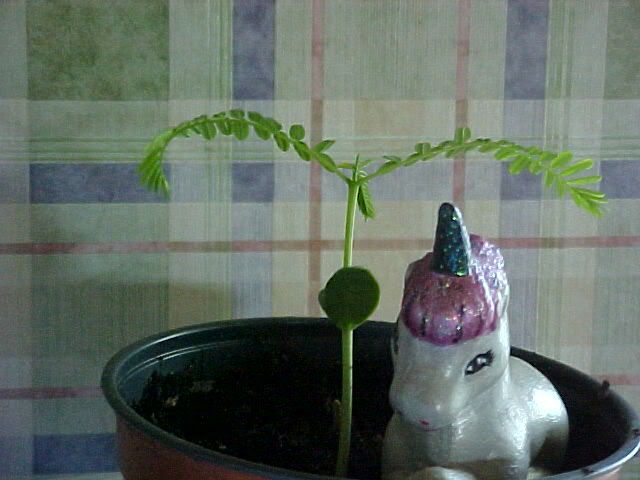
today 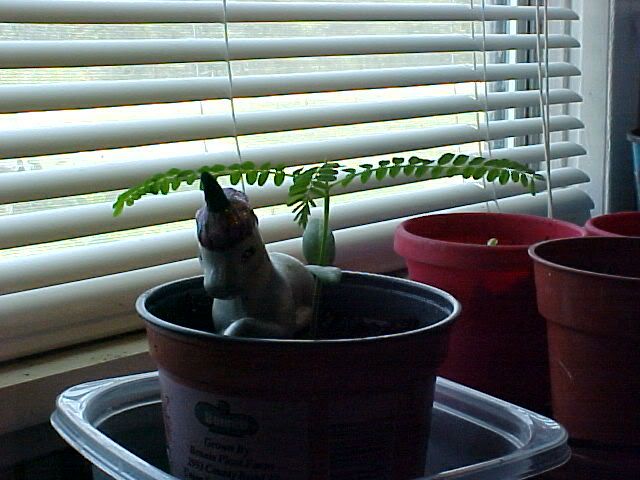
You can see his new leave from this shot. 
Man, at this rate............... what am I going to put him come winter!!!!??? This blog entry has been viewed 530 times
Shhhhhhhhhh, his Highness is sleeping
Category: Royal Poinciana | Posted: Sat Jun 10, 2006 2:26 am Last night I thought Prince Poin was getting a little dry around the feet and that is why he had closed up his leaves and curled up. It was a little limp to the touch. So I placed him back in his container. And this morning he was doing fine. Well, it would seem, he was sleeping as he is doing now. He closes his leaves, curls them under and goes to nite-nite. Here he is just now. He looked just this way last night....just larger! LOL This would explain how he can grow so fast!!! Cuz he sleeps at night! 
All curled under.. 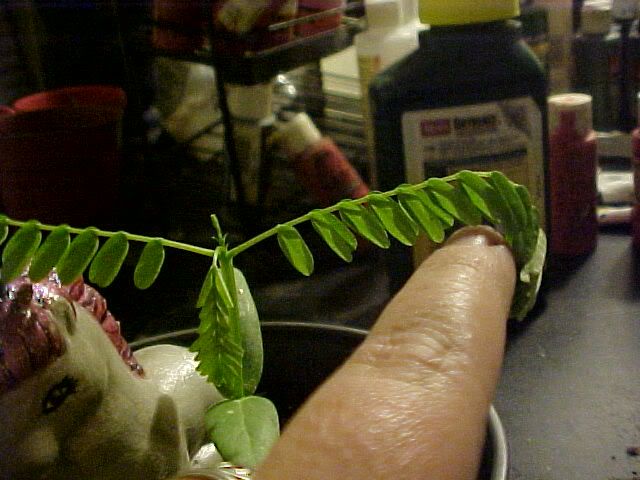
even the new leaf was tired.... 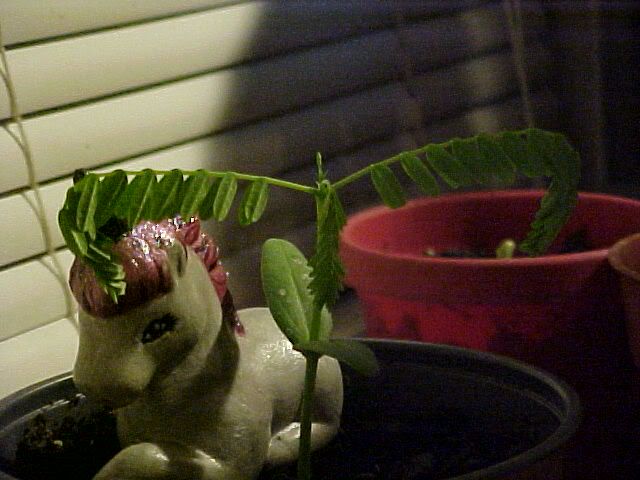
This blog entry has been viewed 585 times
Trouble Shooting roses
Category: Roses | Posted: Fri Jun 09, 2006 7:21 pm PPl think its hard to grow roses. At one time I thought the same. Ive sent more than my share of roses to the Great Rose Garden in the sky. Shameful, I know. But it taught me how to care for them. To me growing roses is no harder then ,say, daisies. Maybe less so, if you know how to do it. Soil First, Let me say here, I dont check my soil. I dont know what they are suppose to grow in. I dont check, add, measure or mix. I grow mine in La clay soil and they are doing great. Sun Second,roses need up to 6 hours of sun a day. Mine are in full sun from the second it comes up to the second it goes down. -Wind protection- Roses need protection from the winds. Light breezes are ok but you dont want high winds taking off with your rose petals. I have learned this the hard way. How I fixed this problem was to plant a wisteria to the direct east of my rose garden. As it grew, it proved wind protection. Worked like a charm. Since I get high winds out of the west too, I planted a fountain grass to the west of the rose garden as a buffer. As its growing, its blocking the high winds. -Daily maintance of your roses- Watering -Roses love to be soaked at least once a week. On really hot days with no rain, I do it twice a week. I spray them every morning when I water the rest of my gardens. I hold the spray on them and count to 20. I know it sounds funny but according to my rain gauge, I have just given each of my roses almost two inches of water. Simple rule of thumb about watering, they say one inch of water for every 6 inches of soil. Being as most of my roses are deeply rooted, this works for me. A rain gauge in your roses is a must have. If it rains, you will know if you need to water your roses the next day or not. It will also tell you if they need their weekly soak from you or if Mother Nature helped. Heres my rule of thumb with this, -If it only rains an inch, then I only count to 10 instead of 20. -If it rains more then 2 inches in a day or night, I wont water the next day. -If the rain gauge is half way full , Ill wait 2 days to water. -If its full, Ill wait two days and start watering again, but will skip their weekly soak. -If it floods (yes it happened), I wont water for a week. Now, if you water your roses in the morning sun, be sure not to get water on the leaves , buds or flowers as the sun will "sunburn" them. -Deadheading your roses- Different ppl do it at different times. I can usually tell by looking at my roses ,when they are getting ready to drop their petals. This is when I deadhead them. To deadhead, is to encourage new blooms. Not to deadhead, is to encourage rose hips and seeds(located just under the flower head). I deadhead all through spring to encourage my rose to bloom all spring and summer. Come late summer and fall, Ill stop deadheading so I can have hips. To deadhead, lay your palm on the flower(wear gloves), wrap your fingers around the dead flower, pointing them towards the base of the stem and pinch just the head off. -Weekly maintence- -Weeding- Be sure there are no weeds or grasses growing into your bush. Roses dont like to share sun or water. And this will also help stop the spead of infections and deter some bugs. -Bi-Weekly maintance- Feeding and fertilizing Every two weeks, I feed my roses a feed just for roses. This has all the goodies they need to grow big and strong. I use only Miracle Gro for Roses. At the sametime I add a mixture of compose and cow manture. Pest and Disease inspection On the same day I feed them, I check them for bugs and infection. When checking for infection, start towards the center bottom, closest to ground and stem, for black spot. I have found, this is where it usually starts. Dont know why but it does. Look for any discolor or deformaties in the leaves and buds. This will be your first clue something isnt right. These are the things you want to look for.(see Pest and Disease blog link for pics of pest and disease I have had to deal with) http://www.gardenstew.com/blog/e283-37-troubleshooting-roses.html Below are the parts of the rose and the pest and the disease most common to that area. ROOTS AND SOIL PESTS Ants Colonies of aphids are sometimes protected by certain ants. In return for this protection the ants are allowed to collect the sweet honeydew. In most cases, the ants protect aphids that have already established themselves on the plant and these aphids or their eggs and keep them through the winter in their nests. In spring, the ants transport these aphids to food plants where they protect them from enemies and at intervals transfer them to new feeding sites. Nematodes Nematodes are small soil-inhabiting worms. Several different types of nematodes damage rose roots. One type, the root-knot nematode, causes small galls or swellings on rose roots. Nematode-damaged roots cannot take up water or fertilizer as well as healthy plants. Nematode-affected plants may be stunted, weak, lack normal green color and do not flower as profusely, and have a shorter life span. Bacterial Crown Gall On roses the symptoms of overgrowths can occur at the crown, bud union or on the roots. Galls are usually round to irregular in appearance and may have a rough exterior. Upon cutting across a gall, a disorganized callus type of tissue is commonly found. The portions closest to the exterior usually contain the actively growing bacteria. However, once the tumor inducing plasmid is introduced into a plant disease can occur without the presence of the vectoring bacteria. CROWN AND BUDUNION PESTS Earwigs Even the name earwig is annoying. It comes from the old superstition that these disgusting insects would crawl inside peoples' ears while they slept. That isn't true, but they seem to crawl everywhere else, including inside rose blooms. Inside roses, earwigs like to eat the stamens, the little stalks on which the pollen producing anthers are positioned. They are not above eating a hole in the petals or leaves too, just for spite. Borers Link to common borers http://www.extension.umn.edu/distribution/horticulture/components/6953_05.html Ants See ants above Canker There are three stem or cane cankers common on roses: Brand Canker, Brown Canker and Stem Canker. More info http://www.wvu.edu/~agexten/ipm/disease/rosecank.htm Bacterial Crown Gall See above Bacterial Crown Gall STEM PESTS Aphids See below of pics http://www.sactorose.org/ipm/84aphids.htm Spittlebugs Spittlebugs are leaf-sucking insects related to and resembling leafhoppers, and sometimes called froghoppers. Leafhoppers The leafhoppers most commonly found on roses are the white apple leafhopper (Typhlocyba pomaria) and the rose leafhopper (Edwardsiana rosae). Scale Insects Old rose stems sometimes become encrusted with white insects called rose scale. These insects called rose scale. These insects suck sap from plants. Waxy adult insects are protected from insecticides. Thrips hey feed by puncturing their host plant or animal prey and sucking up exuding contents. Certain thrips species are beneficial predators that feed only on other insects and mites. Borers See above borers Caterpillars Irregular shaped holes in leaves can be the work of the caterpillar. www.which.net/gardeningwhich/advice/pests/factsheets/rosepests.pdf Stem Sawflies Adult rose stem sawflies are small, dark, non-stinging wasps. The larva is cream colored with a brownish orange head. It is grublike and legless. Larvae will not be seen on exterior surfaces of the plant. Gall Wasps Wasp galls are abnormal plant growths resulting from activity of the tiny, non-stinging cynipid wasps http://www.extension.umn.edu/distribution/horticulture/components/6953_04.html Ants see above ants Borers see above borers Spider Mites Spider mites are extremely small, no larger than moving dots, less than 1/20 inch long, but can be readily observed with a 10X magnifying glass. Spider mites are not insects, but arachnids, along with spiders. Adults are pale green, greenish amber or yellowish, have 8 legs, an oval body, and two red eyespots on a tiny head. Females have a large blotch on each side of the body, from which the name "two-spotted spider mite" derives. The spider mite spins a silk webbing, which becomes obvious in advanced infestations. Spider mites are usually noticed first by their damage, a stippling or light dots on the top of leaves. Turning the leaves over reveals what looks and feels like a light dusting of sand. This is a combination of mites, webbing, eggs and droppings. Snails and Slugs Powdery Mildew Powdery Mildew is a fungal disease, which affects roses. The first signs of powdery mildew appear on young leaves, which hold their color but begin to crinkle. Then small patches of mold appear that develop into spore-bearing fungal filaments on foliage, stems and all other parts of the rose, even the buds (looks like a thin, white powdery substance sitting on growth, which steadily becomes deformed with the spread of the disease). It spreads in white strands, which anchor themselves to the foliage. From there the fungus will draw on the moisture and nutrients within the leaves. As soon as you see the crinkling of young rose leaves be on the watch; the sooner mildew is arrested the better. Mildew can spread thoughout the garden rapidly. http://plantclinic.cornell.edu/FactSheets/powdery/powdery.htm Blackspot Black spot is one of the most common and important diseases of roses throughout the world. It is caused by the fungus Diplocarpon rosae. Black spot will cause a general weakening of the plant so that progressively fewer and fewer blooms are formed if the disease is left unchecked. Plants so weakened are increasingly subject to winter injury. http://pmo.umext.maine.edu/factsht/Spotrose.htm Downy Mildew Downy Mildew is a very common disease of roses which occurs under moist cloudy conditions. The disease is found throughout the United States, Europe and South America. All species of cultivated and wild rose seem to be susceptible. http://plant-disease.ippc.orst.edu/disease.cfm?RecordID=985 Botrytis Blight Botrytis blight mainly affects hybrid tea roses. The fungus attacks leaves and canes, prevents blooms from opening and often causes flower petals to turn brown and shrivel. To diagnose, look closely at cankered stems, brown leaves and flowers. If the fungus is present, the affected areas of plants often are covered with a grayish brown fuzzy growth. Cooler temperatures, moisture and weakened plant tissue create conditions that invite Botrytis blight. Roses under stress will be highly susceptible to this disease. http://www.sactorose.org/ipm/83botrytis.htm Canker see above canker Anthracnose Not much is known about this disease, however, it can be severe under cool moist spring conditions. Wild rose, climbers and ramblers seem most susceptible but hybrid tea and bush roses also get the disease. http://www.sactorose.org/ipm/83anthracnose.htm FOLIAGE AND LEAF PESTS Aphids see aphids above Spittlebugs See spittlebugs above Leafhoppers See leafhoppers above Scale Insects See scale insects above Thrips see thrips above Beetles Because there is such a large varity of beetles that can be found on your roses, you will have to research this more. Start off by googling " beetles on rose ". Fuller's Rose Weevils The rose curculio or rose weevil is a reddish and black weevil with a distinctive long snout on the head. It is about 1/4 inch (5-6 mm) in body lenght. The snout is used for drilling and feeding on flower buds. Caterpillars See above caterpillars Rose Slugs/Rose Sawflies See above Sawflies Gall Wasps see above Gall wasps Ants See above ants Leafcutter Bees To most gardeners, the leafcutter bee is solely identified by the circular holes cut out of the edges of their rose leaves. Spider Mites Slugs and Snails Powdery Mildew see above Powdery Mildew Blackspot see above Blackspot Rust small, powdery pustules of bright orange or yellow spore masses, occurring on lower leaf surfaces or other green parts. Highly susceptible rose varieties are defoliated, weakening the plant significantly. Downy Mildew see above Downy mildew Botrytis Blight see above Botrytis Blight Canker see above canker Anthracnose see above Anthracnose Rose Mosaic The symptoms associated with Rose mosaic virus (RMV) are highly variable. Yellow wavy line patterns, ring spots and mottles in leaves will occur on some varieties of roses sometime during the growing season. In general, symptoms are most evident in the spring. Yellow net and mosaic symptoms on the leaves are also associated with RMV and detract from the overall quality of the plant. Infected plants become weakened and are more sensitive to damage caused by other stresses, such as drought or low temperatures. http://www.sactorose.org/ipm/83rosemosaic.htm Rose Rosette Rose rosette disease (RRD), a disease believed to be caused by a virus, has been spreading through much of the wild rose population of the midwestern, southern and eastern United States for years, and has now been confirmed in cultivated roses in Virginia. This disease is of great concern to the nursery industry and to many home gardeners because it is known to be lethal to the wild multiflora rose (Rosa multiflora) and it is potentially lethal to many ornamental rose species and cultivars. http://www.ext.vt.edu/pubs/plantdiseasefs/450-620/450-620.html BUD AND GROWING TIP PESTS Aphids see aphids above Spittlebugs see Spittlebugs above Leafhoppers see Leafhoppers above Thrips see Thrips above Katydids The members of this group belong to the Order Orthoptera (Orthos, straight; pteron, wing). They are characterized having simple metamorphosis, chewing mouthparts, the hind legs have enlarged femorea specialized for jumping and with stridulating organs present. The group also has two pairs of well developed wings with the first or upper pair being leathery and elongate often called "tegmina". The hind wings are membranous and fold fanlike longitudinally under the first pair of wings . Well developed wings are found on adults but they may also be absent or even rudimentary on some species. The wings are rudimentary in immature insects thus these immature insects are not able to fly as the adults. These insects are mainly plant feeders and some are very destructive pests. They are diurnal and nocturnal in habit. The stridulating organs at the base of the femora and abdomen allows many of these insects to "sing" and make very distinctive songs which they use to communicate among with each other. http://www.sactorose.org/ipm/84grasshoppers.htm Flea Beetles Because there are so many different types of Flea Beetles, you will need to research this. Start by googling " flea beetles on roses ". Rose Curculios (Weevils) see above Fuller's Rose Weevils Caterpillars see above Caterpillars Stem Sawflies see above Sawflies Ants see above Ants Spider Mites see above Spider Mites Slugs and Snails Powdery Mildew See Powdery Mildew above Botrytis Blight see Botrytis Blight above Hoplia beetles http://www.ipm.ucdavis.edu/PMG/PESTNOTES/pn7499.html OPEN FLOWER PESTS Aphids see Aphids above Thrips see Thrips above Earwigs see Earwigs above Scarab Beetles The most common is the Japanese beetle and Rose Chafer. Research both. Diabrotica Beetles or Cucumber Beetle Should you spot a green "ladybug," you've just stumbled across something much less desirable, the Western Spotted Cucumber Beetle (Diabrotica undecimpunctata undecimpunctata). There are two types of cucumber beetles, both voracious feeders, one striped, the other spotted. The spotted variety is the one most likely to be confused with a lady beetle. The adult is about ü inch long, yellowish green with twelve black wing spots. The larvae are about ý inch long, white, with a brown head and "butt." Rose Curculios (Weevils) see Fuller's Rose Weevils above Caterpillars see Caterpillars above Ants see Ants above Botrytis Blight see Botrytis Blight above -Preventive measures- Not only would treat for what you may have found, but you treat from what you dont want. Preventive measures are a must for pest and disease free roses. Organic or chemcial treatments, theres a varity out there for you to choose from. For organic treatments and prevention please see my blog on this. http://www.gardenstew.com/blog/e283-57-organic-treatments-and-prevention-for-roses.html Remember, if you spray your roses for bugs, this will keep them at bay. That does include butterflies and bees. Sadly, I have learned this the hard way. You must remember too, that there are little nasties that want to get inside of your roses and eat it from the inside out or ones that will lay their eggs in the ground at the roots and the babies will kill your roses through the roots. Be sure to check for any signs of this on the trunk and at the base of your rose bush. NoteWhen you prune your roses, always make sure you seal the wood with some sort of wood sealer. This will keep out any bugs that want to bore into your rose stems. I use Almers Wood glue. Takes a second to do but is a must in preventive care. Hope this helps! If I can grow roses, anyone can! I am a lazy gardener! HAHA! One last note here I was told not long ago, that this person had talk to one of his friends that owned a rose nursery and was told that he will purposly mislabel a rose for a sale. Its common knowledge that roses are mislabled, sometimes with made up names, just to get rid of them. I have found this to be VERY true. I have gotten roses home to find a different label on them than what the sales tag or display has. Tho sametimes this is a good thing. You can get an expenisve rose for a discount.Just be forewarned. Links to helpful rose sites for pest and disease http://www.pested.msu.edu/Resources/slides/OrnamentalCat3B/OrnChap6script.htm If you are experiencing a disease or pest that you have not seen on this page, please Pm me or leave me a messege here and Ill help you ID it. Feel free to ask questions. As you learn , I learn. Last edited: Sat Jun 17, 2006 10:48 pm This blog entry has been viewed 5906 times
Prince Poins- Day 5
Category: Royal Poinciana | Posted: Fri Jun 09, 2006 2:50 pm Well, I learned he like to have his feet wet. I had taken his pot out of the ziplocke container it was sitting in. Last night the leaves curled up and were starting to droop. I put him back in the container and water him from the top and the bottom. He is now sitting in about a half inch of water. yesterdays pic 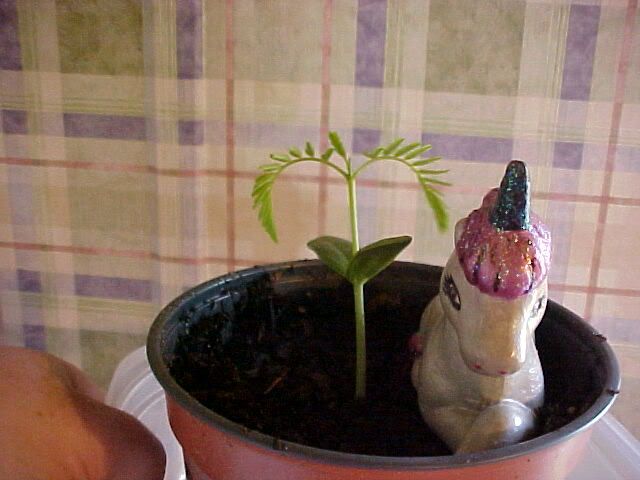
Todays pic 
This blog entry has been viewed 539 times
His Highness gets a friend
Category: Royal Poinciana | Posted: Thu Jun 08, 2006 3:59 pm I decided to let Sarah the unicorn keep Prince Poins company. She will also help keep track of his growth. Todays pics of His Highness. This is Sarah 
His Highness. I just love the way the leaves are curling under and he has new ones coming in!!! 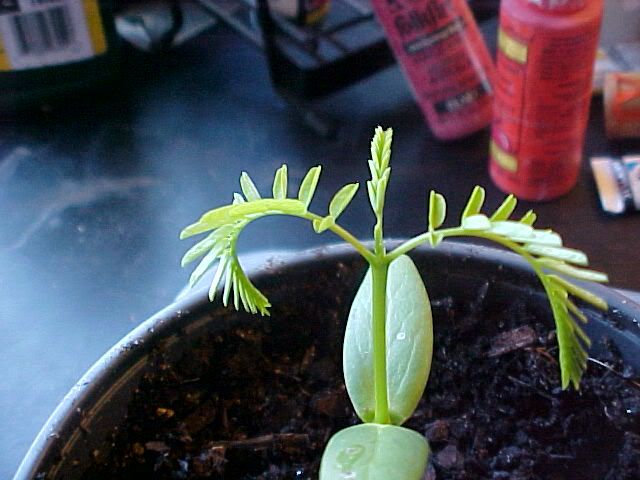
Prince Poins and Sarah 
This blog entry has been viewed 573 times
You're reading one of many blogs on GardenStew.com.
Register for free and start your own blog today. |
Entries by Category
All Categories
Archives
All Entries |
